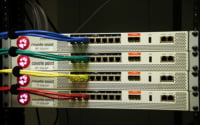Linux Disk Management: Installing and Using ‘GParted’

Are you looking to manage your disk partitions in Linux? Like a skilled architect, the GParted command in Linux allows you to design and modify your disk partitions with precision. However, installing and using GParted might seem a bit complex, especially for beginners. But don’t worry, this tool is worth mastering. Also, it’s readily available on most package management systems, making the installation process straightforward once you know the steps.
In this guide, we will walk you through the process of installing and using the GParted command in Linux. We will show you methods for both APT and YUM-based distributions, delve into compiling GParted from source, installing a specific version, and finally, how to use the GParted command and ensure it’s installed correctly.
So, let’s dive in and begin installing GParted on your Linux system!
TL;DR: How Do I Install and Use the GParted Command in Linux?
In most Linux distributions, you can install GParted by running the command
sudo apt-get install gparted. After installation, you can launch GParted with the commandsudo gparted.
sudo apt-get update
sudo apt-get install gparted
sudo gparted
# Output:
# [GParted interface opens]
This is just a basic way to install and use the GParted command in Linux, but there’s much more to learn about GParted. Continue reading for more detailed information and advanced usage scenarios.
Table of Contents
- Understanding GParted: A Powerful Disk Partitioning Tool
- Installing GParted from Source Code
- Installing Different Versions of GParted
- Using GParted and Verifying Installation
- Exploring Alternative Disk Partitioning Tools
- Overcoming Challenges with GParted
- Understanding Disk Partitioning in Linux
- The Bigger Picture: Disk Partitioning and System Administration
- Wrapping Up: Mastering the GParted Command in Linux
Understanding GParted: A Powerful Disk Partitioning Tool
GParted, short for GNOME Partition Editor, is a free and open-source disk partitioning utility. It allows you to resize, move, and manage disk partitions on your Linux system, providing a graphical interface for ease of use. GParted supports a wide range of file systems, making it a versatile tool for disk management tasks.
Why use GParted? It’s intuitive, powerful, and provides a visual representation of your disk layout. This makes it easier to understand your disk usage and manage partitions effectively.
Now that you know what GParted is and why it’s useful, let’s dive into how to install it on your Linux system.
Installing GParted with APT
If you’re using a Debian-based distribution like Ubuntu, you can install GParted using the APT package management system. Here’s how:
sudo apt update
sudo apt install gparted
# Output:
# [Installation progress and completion message]
The first command updates your package lists to ensure you’re getting the latest version. The second command installs GParted. If the installation is successful, you should see a completion message in your terminal.
Installing GParted with YUM
For those using a Red Hat-based distribution like CentOS or Fedora, you can use the YUM package manager to install GParted. Here’s the command sequence:
sudo yum check-update
sudo yum install gparted
# Output:
# [Installation progress and completion message]
Like the APT commands, the first YUM command checks for updates, and the second installs GParted. Again, look for the completion message to confirm a successful installation.
Installing GParted with Zypper
If you’re using an openSUSE distribution, you can use the Zypper package manager to install GParted. Here’s how:
sudo zypper refresh
sudo zypper install gparted
# Output:
# [Installation progress and completion message]
The first command refreshes your package lists, and the second installs GParted. As with the previous methods, a completion message will confirm a successful installation.
Installing GParted from Source Code
Sometimes, you may need to install GParted from source code. This could be due to the unavailability of the package in your Linux distribution’s repository, or you might want to install a specific version of GParted. Here’s how you can do it:
sudo apt-get install build-essential
wget https://downloads.sourceforge.net/project/gparted/gparted/gparted-1.3.1/gparted-1.3.1.tar.gz
tar xvf gparted-1.3.1.tar.gz
cd gparted-1.3.1/
./configure
make
sudo make install
# Output:
# [Compilation and installation progress and completion message]
The above commands will download the GParted source code, extract it, navigate into the extracted directory, configure the package, compile it, and finally install it.
Installing Different Versions of GParted
Installing Different Versions from Source
To install a different version of GParted from source, you simply need to change the version number in the download URL. For example, to download version 1.2.0, you would use:
wget https://downloads.sourceforge.net/project/gparted/gparted/gparted-1.2.0/gparted-1.2.0.tar.gz
tar xvf gparted-1.2.0.tar.gz
cd gparted-1.2.0/
./configure
make
sudo make install
# Output:
# [Compilation and installation progress and completion message]
Installing Different Versions with Package Managers
APT
With APT, you can install a specific version of a package using the = operator. For example, to install GParted version 1.2.0, you would use:
sudo apt-get install gparted=1.2.0-1
# Output:
# [Installation progress and completion message]
YUM
With YUM, you can list all available versions of a package using the --showduplicates option. Then, you can install a specific version using the -x option. For example:
yum --showduplicates list gparted
yum install gparted-1.2.0-1
# Output:
# [Installation progress and completion message]
Key Changes in Different Versions
| Version | Key Changes |
|---|---|
| 1.3.1 | Added support for exFAT filesystems |
| 1.2.0 | Added support for btrfs filesystems |
| 1.1.0 | Added support for reading disk usage |
Using GParted and Verifying Installation
Basic Usage of GParted
Once you’ve installed GParted, you can launch it using the gparted command. Here’s an example:
sudo gparted
# Output:
# [GParted interface opens]
Verifying GParted Installation
You can verify that GParted is installed and check its version by using the --version option:
gparted --version
# Output:
# GParted 1.3.1
This command will display the version of GParted that is currently installed on your system.
Exploring Alternative Disk Partitioning Tools
While GParted is a powerful and user-friendly tool for managing disk partitions, it’s not the only game in town. Linux provides several other command-line utilities for disk management, including fdisk and parted. Let’s take a look at these alternatives.
Using fdisk Command
fdisk is a text-based utility that comes pre-installed on most Linux distributions. It allows you to view, create, resize, and delete disk partitions.
Here’s an example of how to list all partitions using fdisk:
sudo fdisk -l
# Output:
# [List of all partitions]
This command will display a list of all partitions on your system.
Using parted Command
parted is another command-line utility for managing disk partitions. It’s more modern than fdisk and supports more file systems.
Here’s an example of how to list all partitions using parted:
sudo parted -l
# Output:
# [List of all partitions]
This command will display a list of all partitions on your system.
Comparing GParted, fdisk, and parted
| Tool | User Interface | File System Support | Flexibility |
|---|---|---|---|
| GParted | Graphical | Extensive | High |
| fdisk | Text-based | Limited | Medium |
| parted | Text-based | Extensive | High |
As you can see, while fdisk and parted are powerful tools, GParted’s graphical user interface and extensive file system support make it a more user-friendly option, especially for beginners.
However, if you’re comfortable with the command line and need to manage disk partitions on a system without a graphical user interface, fdisk and parted are excellent alternatives.
Overcoming Challenges with GParted
Like any software, GParted is not without its challenges. Here, we’ll discuss some common issues you may encounter while using GParted and provide solutions to help you overcome them.
GParted Not Found Error
After installation, you might encounter an error that says ‘gparted: command not found’. This usually happens when the system can’t locate the GParted binary. Here’s how to fix it:
whereis gparted
# Output:
# gparted: /usr/sbin/gparted /usr/share/gparted /usr/share/man/man8/gparted.8.gz
The whereis command will tell you where GParted is installed. If it’s not in your PATH, you can add it using the export command.
Unable to Resize Partition
Sometimes, you might encounter issues while trying to resize a partition with GParted. This could be due to several reasons, such as the partition being in use or insufficient free space. Make sure to backup your data before resizing partitions to avoid data loss.
GParted Freezes or Crashes
GParted might freeze or crash due to various reasons such as low memory or disk space. In such cases, check your system’s resources and ensure that GParted is up to date.
Using GParted Safely
When dealing with disk partitions, it’s crucial to proceed with caution. A small mistake can lead to data loss. Always backup your data before making changes to your partitions, and only use GParted (or any partitioning tool) if you understand the implications of your actions.
Remember, while GParted is a powerful tool, it does not safeguard against user errors. Therefore, understanding the basics of disk partitioning and the specific commands you’re using is crucial for a successful and safe disk management experience.
Understanding Disk Partitioning in Linux
Before we delve deeper into the usage of GParted, it’s essential to understand the basics of disk partitioning in Linux. Disk partitioning is the act of dividing a hard disk into multiple storage units referred to as partitions. Each partition functions as a separate disk, with its own file system.
Why Disk Partitioning Matters
Disk partitioning is crucial for several reasons. First, it allows you to organize your data better. For instance, you can have a partition for your operating system and another for your personal files. This separation makes it easier to manage your files and can enhance your system’s performance.
Second, partitioning can improve your system’s security. By separating your system files from your personal files, you can limit the damage that can be caused by a system crash or a security breach.
Understanding File Systems
When you create a partition, you need to choose a file system for it. The file system controls how data is stored and retrieved on the partition. Linux supports several file systems, including ext4, XFS, and Btrfs. Each file system has its own advantages and disadvantages, and the choice of file system can impact your system’s performance.
Here’s an example of how to list the file systems supported by your Linux distribution:
ls /lib/modules/$(uname -r)/kernel/fs
# Output:
# [List of supported file systems]
This command will display a list of all file systems supported by your current Linux kernel.
Partitioning Schemes
There are several partitioning schemes you can use when setting up your Linux system. The most common scheme includes a root partition (/), a swap partition, and a home partition (/home). The root partition contains the operating system, the swap partition is used for swapping, and the home partition contains user files.
Here’s an example of how to view your current partitioning scheme using the lsblk command:
lsblk
# Output:
# [Current partitioning scheme]
This command will display your current partitioning scheme, including the size and mount point of each partition.
By understanding the basics of disk partitioning in Linux, you can use GParted more effectively and make informed decisions about your disk management strategy.
The Bigger Picture: Disk Partitioning and System Administration
Disk partitioning is more than just a technical task—it’s a fundamental aspect of system administration and data management. Effective disk partitioning can lead to optimized system performance, improved data organization, and enhanced system security.
The Impact of Disk Partitioning on System Performance
The way you partition your disk can have a significant impact on your system’s performance. For instance, separating your operating system files from your personal files can prevent your system from slowing down due to disk clutter. Similarly, having a dedicated swap partition can improve your system’s performance by providing additional memory resources.
Disk Space Allocation in Linux
Another important aspect of disk management is disk space allocation. Linux provides several tools and commands for monitoring disk usage, such as df and du. Understanding how to use these tools can help you manage your disk space effectively and avoid running out of space unexpectedly.
Here’s an example of how to check your disk usage using the df command:
df -h
# Output:
# [Current disk usage in human-readable format]
This command will display your current disk usage in a human-readable format (i.e., in bytes, kilobytes, megabytes, etc.).
File Systems and Their Role in Disk Management
As we mentioned earlier, the choice of file system can impact your system’s performance. Different file systems have different features and capabilities, and understanding these differences can help you choose the right file system for your needs. For instance, the ext4 file system is known for its robustness and reliability, while the XFS file system is known for its high performance.
Further Resources for Mastering Disk Partitioning
If you’re interested in learning more about disk partitioning and disk management in Linux, here are some resources you might find useful:
- The Linux System Administrator’s Guide: An in-depth guide to system administration in Linux, including a comprehensive section on disk partitioning.
Top 6 Partition Managers: A detailed comparison of the 6 most commonly used partition managers.
The Linux File Systems Explained: A thorough explanation of the various file systems supported by Linux and their respective features and advantages.
Wrapping Up: Mastering the GParted Command in Linux
In this comprehensive guide, we’ve navigated the landscape of disk partitioning in Linux using the GParted command. We’ve explored the installation process across different Linux distributions, delved into advanced usage scenarios, and touched on the fundamentals of disk partitioning.
We embarked on our journey with the basics of installing the GParted command in Linux, covering APT, YUM, and Zypper package managers. We then advanced to installing GParted from the source code, installing different versions, and verifying the installation. We also explored how to use GParted and the key changes in different versions.
Along the way, we tackled common challenges that users might face when using GParted, such as the ‘command not found’ error, issues with resizing partitions, and GParted freezing or crashing. We also discussed the importance of proceeding with caution when dealing with disk partitions to avoid data loss.
| Tool | Interface | Flexibility | File System Support |
|---|---|---|---|
| GParted | Graphical | High | Extensive |
| fdisk | Text-based | Medium | Limited |
| parted | Text-based | High | Extensive |
In the end, we expanded our view beyond GParted, discussing alternative tools like fdisk and parted, and the role of disk partitioning in system administration and data management. We also provided resources for further learning and mastering disk partitioning.
Whether you’re a beginner just starting out with GParted or an experienced user looking to brush up your knowledge, we hope this guide has provided you with a deeper understanding of the GParted command in Linux and its capabilities. Now, you’re well-equipped to manage your disk partitions effectively and efficiently. Happy partitioning!


